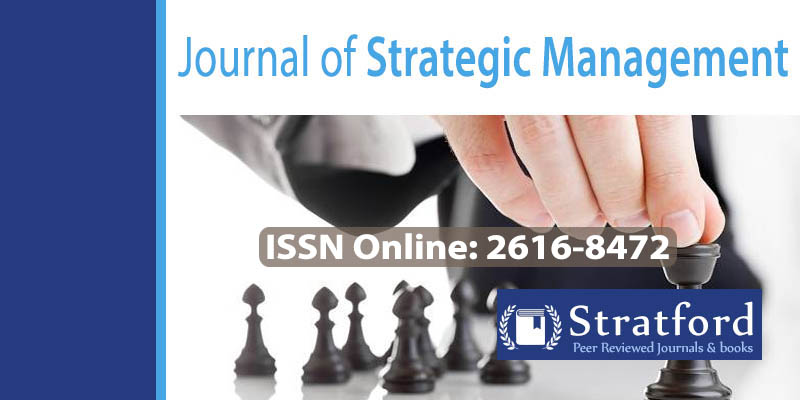Influence of Planning Strategy on Performance of County Government in Kenya
DOI:
https://doi.org/10.53819/81018102t30112Abstract
The performance of county governments has always been primarily assessed in terms of the levels of pending bills, own-source revenue collections, development funds absorption rates, infrastructural developments initiated and completed, and staff skills and capabilities development. Both the Controller of Budget's County Governments Annual Budget Implementation Review Reports and the annual Auditor General's Audit Reports have cited underperformance by most counties in these areas. However, a few counties have achieved remarkable results in the same areas with similar resources, raising the question of whether variations in the planning strategies used in different resource allocation processes can explain these performance differences. The purpose of this study was therefore to establish the influence of planning strategy on the performance of county governments in Kenya. This study was necessary to identify key county performance indicators as a means of allocating resources to ensure effective service delivery. The study was based on the Resource-Based Theory (View) and the McKinsey 7s Framework. It was conducted in Migori County, with the unit of analysis being 102 county government employees, including chief officers, directors, and heads of departments who are directly involved in the formulation, implementation, monitoring, and evaluation of resource allocation strategies. Migori County was selected for the study because it is median in terms of performance and has similar characteristics to other counties. The study was conducted using a census survey with a descriptive research design. Data was collected using a questionnaire. A pilot test was conducted in Homa Bay County to test the reliability of the data collection instrument. Homa Bay County was selected because it has similar characteristics to Migori County. The quantitative data collected was presented in tables, frequencies, means, standard deviations, figures, and percentages. Pearson's Product Moment Coefficient was used to test the strength of the relationships. Inferential statistics were then applied using simple and multiple regressions to test the influence of the independent variables on the dependent variable. Diagnostic tests were conducted to establish whether the data met the threshold for regression analysis.
Keywords: Planning, Strategy, Performance, County Governments, Kenya
References
Akinyole, S. T and Fasogbon, O .IO. I (2007): Impact of Strategic Planning on Organizational Performance and Survival. Retrieved from scialert.net/fultext/? doi=ijbn.2007/6271 n ml,
Alotaibi, A. (2020). Deep generative adversarial networks for image-to-image translation: A review. Symmetry, 12(10), 1705.
Arasa, R., & Obonyo, P. K. (2012). The relationship between strategic planning and firm performance.
Cooper, D. R., & Schindler, P. S. (2010). Business research methods. (11thed.). NewDelhi: Tata McGraw-Hill Publishing Limited.
Correlation analysis for the behavioral sciences. (3rd Ed.). New York: Routledge
David, R. J., & Collins Jr, J. W. (1997). Differing birth weight among infants of US-born blacks, African-born blacks, and US-born whites. New England Journal of Medicine, 337(17), 1209-1214.
Dobre, O. I. (2013). Employee motivation and organizational performance. Review of applied socio-economic research, 5(1).
Ellinger, D.D and Swendsen, S (2021): Impact of Human Resource Planning on Organizational Performance: A Case of Manufacturing Firms in Austria. Retrieved from https://stratfordjournals.org
Gomera, W. C., & Apiola, M. (2015, September). Improving MFI-MB interaction with technology: An explorative study in Dar es Salaam, Tanzania. In AFRICON 2015 (pp. 1-8). IEEE.
Guerard, J. J., & Arey, J. S. (2013). Critical evaluation of implicit solvent models for predicting aqueous oxidation potentials of neutral organic compounds. Journal of Chemical Theory and Computation, 9(11), 5046-5058.
Karami, G., & Garnich, M. (2005). Effective moduli and failure considerations for composites with periodic fiber waviness. Composite Structures, 67(4), 461-475.
Monye, M. C., & Ibegbulem, A. B. (2018). Effect of strategic planning on organizational performance and profitability. International Journal of Business & Law Research, 6(2), 31-40.
Monye, M. C., & Ibegbulem, A. B. (2018). Effect of strategic planning on organizational performance and profitability. International Journal of Business & Law Research, 6(2), 31-40.
Mugenda, A. G., & Mugenda, A. (2013). Qualitative research methods. Nairobi, Kenya.
Pearce, P. (2012). The Ulysses factor: Evaluating visitors in tourist settings. Springer Science & Business Media.
Pierce, J. P., Natarajan, L., Caan, B. J., Parker, B. A., Greenberg, E. R., Flatt, S. W., ... & Stefanick, M. L. (2007). Influence of a diet very high in vegetables, fruit, and fiber and low in fat on prognosis following treatment for breast cancer: The Women's Healthy Eating and Living (WHEL) randomized trial. Jama, 298(3), 289-298.
Reeves, M., & Haanaes, K. (2015). Your strategy needs a strategy: How to choose and execute the right approach. Harvard Business Review Press.
Simiyu, C. N. (2013). Remittance and household expenditures in Kenya.
Taylor, J. (2008). Project scheduling and cost control: planning, monitoring and controlling the baseline. J. Ross Publishing.


